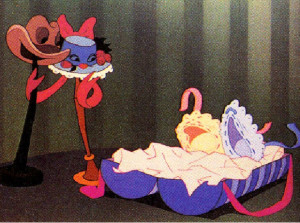Jim on Film
Page 4 of 7
The Three Caballeros is also an immersive experience of sorts, whereas Saludos Amigos is almost an introduction to The Three Caballeros. This is not to belittle Saludos Amigos, which is a fun film that stands on its own. Both are very charming and quite funny, but Saludos Amigos is a string of shorts and The Three Caballeros is a full program with a light semblance of a story. And their hearts and souls are very different.
In Saludos Amigos, the emphasis of the animated segments is humor. There are some clever visuals with anthropomorphic planes but only the Aquarela do Brasil aspires to the visual inventiveness of the earlier films.
In The Three Caballeros, on the other hand, we have another movie with most of the stops pulled out. Visually, Baia, while using some techniques of limited animation, is a feast, including use of the multiplane camera. But even though most of it is not filled with the intricate detail of the earlier films, it is still beautiful in its use of colors and styles, such as in the Mary Blair Christmas drawings, the train to Baia, and its mix of animation and live-action.
Again, there’s a strong level of creativity at work in this film. The Os Quindins De Yaya segment with Aurora Miranda has always been a favorite. There are elements of creativity and imagination that are astounding, such as when the two dancers transform into fighting roosters and when Aurora Miranda sets the city streets and buildings to life, bouncing to the Latin beat. This creativity only stops with the fast-paced fury of imagination that ends the picture.
With The Three Caballeros, we have the first time there is a repetition of an idea, that of the animated soundtrack, which was used in Fantasia. But even then, though it is a familiar concept, the artists aren’t satisfied in repeating themselves. They suck Donald into the fun, resulting in hilarious and fresh visuals.

Make Mine Music
(c) Disney
When I first started studying Disney and learned that there existed films called Make Mine Music or The Adventures of Ichabod and Mister Toad, all I could ever learn about them as a whole was that they were mashed potatoes and gravy, package films, or stopgaps. It would be many years before I could view them in their original glory.
It must have been very difficult for the artists to have poured so much of themselves into films like Pinocchio and Bambi to not have a single-story feature to dedicate themselves to. Also, it must have seemed odd to critics and audiences, if not frustrating, to have seen such masterful works as Disney’s earlier films but to see a trend away from that. They wouldn’t have the benefit of knowing the studio’s financial struggles and wouldn’t realize that Disney wanted to return to single-story features. Eight long years passed between Bambi and Cinderella, which would be the equivalent of, in today’s time, not seeing a great Disney animated film after Pocahontas.
Seeing these films in chronological order, though, shed further illumination on them. While these are not single-story features, it is very clear that the artists made them labors of love because they maintain the high level of creativity and beauty found in the films from the Golden Age. In Make Mine Music, Blue Bayou, of course, was originally created for Fantasia, but even beside that, Without You and Two Silhouettes are beautiful pieces, and All the Cats Join In and After You’ve Gone are attempts to impress the audience as well. While The Martins and the Coys, Casey at the Bat, Peter and the Wolf, and to a lesser extent, The Whale Who Wanted to Sing at the Met are designed in the more caricatured shorts-style drawing, Johnnie Fedora and Alice Bluebonnet is also quite beautiful. And even if those other segments are not as distinctive in style, they all have the mark of love on them-either in execution, storytelling, or creativity.
It’s interesting to watch these films and see the use of Disney’s bag of tricks throughout them. For example, there is use of the expensive multiplane camera throughout these films, including The Three Caballeros. Even the connecting section of Fun and Fancy Free uses the multiplane camera, not to mention the use of it in both of its stories. And this attention to detail is prevalent in the films through to The Adventures of Ichabod and Mister Toad. A good example is in the intro sequence of Melody Time where there are singing masks, echoed by shadows behind. It would have been cheaper to leave the shadows off, but that was not the case. Similarly, in Once Upon a Wintertime, it would have been cheaper to animate the water without the stylistic swirling lines. Had Disney only wanted to churn out films that would make a quick buck, this detail would not be apparent.
Another carryover element from the early films is the use of abstract and surrealistic imagery. Beginning with many of the elements of Fantasia, continuing through Pink Elephants on Parade in Dumbo, to Aquarela do Brasil of Saludos Amigos, through much of The Three Caballeros, into three of the four visual-based segments of Make Mine Music, the dream sequence in Bongo, and three sequences from Melody Time, this highly non-linear method of creation found a home in Disney films. With the exception of some ideas in Alice in Wonderland, these exciting sequences would not find a place in another Disney feature for a long time.
